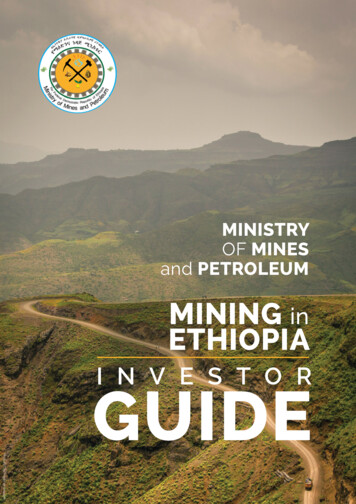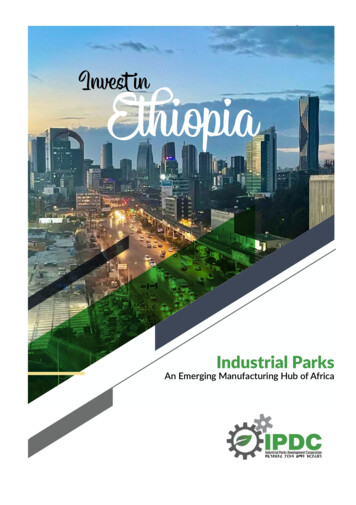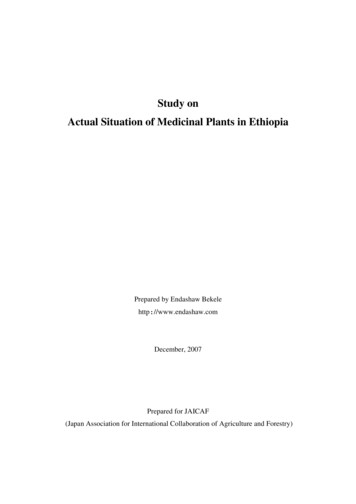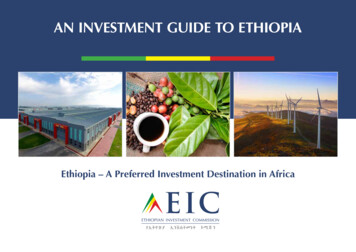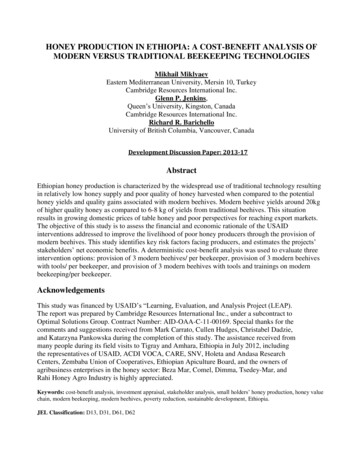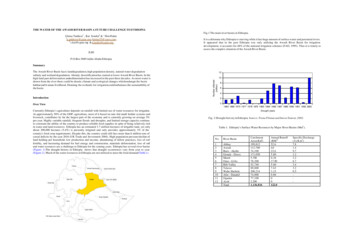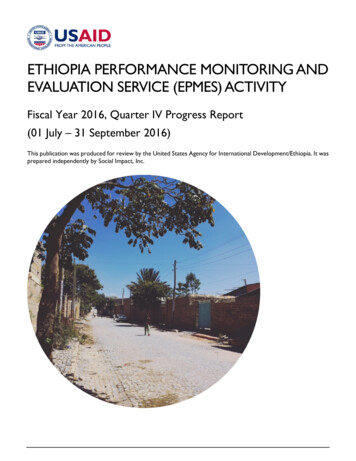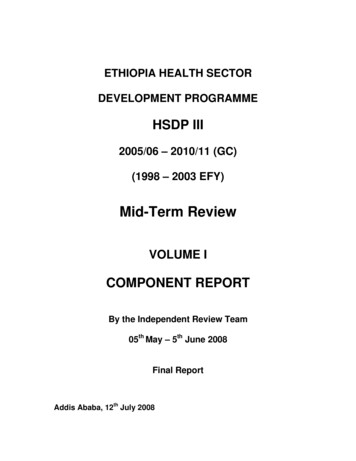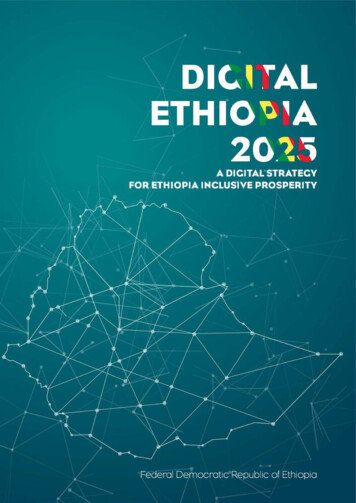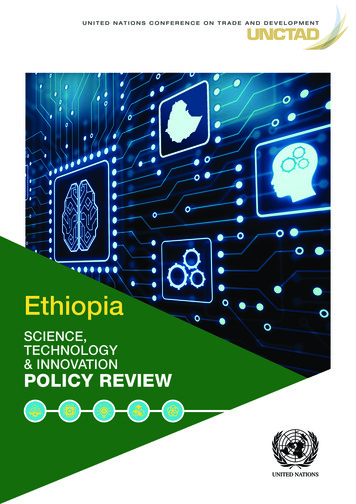
Transcription
U N I T E D N AT I O N S C O N F E R E N C E O N T R A D E A N D D E V E L O P M E N TEthiopiaSCIENCE,TECHNOLOGY& INNOVATIONPOLICY REVIEW
U N I T E D N AT I O N S C O N F E R E N C E O N T R A D E A N D D E V E L O P M E N TEthiopiaSCIENCE,TECHNOLOGY& INNOVATIONPOLICY REVIEWGeneva, 2020
2020, United NationsThe work is available through open access, by complying with the Creative Commons licence created forintergovernmental organizations, at e designations employed and presentation of material on any map in this work do not imply theexpression of any opinion whatsoever on the part of the United Nations concerning the legal statusof any country, territory, city or area or of its authorities, or concerning the delimitation of its frontiersor boundaries.Photocopies and reproductions of excerpts are allowed with proper credits.This publication has been edited externally.United Nations publication issued by the United Nations Conference on Trade and Development.UNCTAD/DTL/STICT/2020/3eISBN 978-92-1-004822-4
Science, Technology and Innovation Policy Review of EthiopiaExplanatory notesReferences in the text to the United States are to the United States of America and those to the UnitedKingdom are to the United Kingdom of Great Britain and Northern Ireland.The term “dollar” ( ) refers to United States dollars, unless otherwise stated.7KH WHUP qELOOLRQr VLJQLƄHV PLOOLRQ The term “tons” refers to metric tons.The term “MT” refers to megatons.7KH WHUP q0:r VLJQLƄHV PHJDZDWWV Annual rates of growth and change refer to compound rates.([SRUWV DUH YDOXHG )2% DQG LPSRUWV &,) XQOHVV RWKHUZLVH VSHFLƄHG 8VH RI D GDVK t EHWZHHQ GDWHV UHSUHVHQWLQJ \HDUV VXFK DV t VLJQLƄHV WKH IXOO SHULRG LQYROYHG LQFOXGLQJ WKH LQLWLDO DQG ƄQDO \HDUV Q REOLTXH VWURNH EHWZHHQ WZR \HDUV VXFK DV VLJQLƄHV D ƄVFDO RU FURS \HDU A dot (.) in a table indicates that the item is not applicable.Two dots (.) in a table indicate that the data are not available, or are not separately reported.A dash (–) or a zero (0) in a table indicates that the amount is nil or negligible.Decimals and percentages do not necessarily add up to totals because of rounding.iii
Science, Technology and Innovation Policy Review of EthiopiaPrefaceUNCTAD Science, Technology and Innovation Policy Reviews (STIP Reviews) are an analytical and policylearning process for a country’s science, technology and innovation (STI) stakeholders to reach a clearerunderstanding of the key strengths and weaknesses of their innovation systems and identify strategicpriorities for its development. The result of this process is documented in the STIP Review document andconsidered at the United Nations Commission on Science and Technology for Development (CSTD).The analysis is based on the Framework for Science, Technology and Innovation Policy Reviews (UNCTAD,2019). STIP Reviews aim to assist countries to align STI policies with their development strategies whilepromoting sustainable development and the achievement of the Sustainable Development Goals (SDGs);build stronger national capacities in STI; assess the National Innovation System and priority sectors andindustries; provide recommendations to improve technological capabilities; and encourage innovation.The reviews make a systematic effort to involve a broad range of stakeholders to build national consensus.The STIP Review of Ethiopia was prepared at the request of the Government to assist the Ministryof Innovation and Technology in preparing a new STI policy. The primary objectives of this report aretwofold: (1) to appraise the extent to which rapid economic growth in Ethiopia has contributed to localtechnological learning and upgrading, and created the necessary conditions for the development of aviable National Innovation System (NIS); and (2) to develop a national STI policy framework that thecountry needs to implement the SDGs and the national development vision, particularly the export-orientedand manufacturing sector-based industrialization strategy. At the request of the Government, the STIPReview provides a deep-dive analysis of two sectors that could serve as case studies for understandingthe relationship between the national STI policy framework and technical learning and innovation at thesectoral level: apparel and textile for resource-based labour-intensive exports and pharmaceuticals forknowledge-intensive import substitution.7KH 67,3 5HYLHZ LV EDVHG RQ IDFW ƄQGLQJ PLVVLRQV WR (WKLRSLD ZKLFK LQFOXGHG LQWHUYLHZV ZLWK representatives of the Government, the private sector and specialized public institutions, conducted inDecember 2018 and March 2019, and current relevant data. The missions received the full support ofthe Ministry of Innovation and Technology and members of the Interministerial Committee established toassist with the STIP Review process, as well as other stakeholders.Geneva, November 2019v
Science, Technology and Innovation Policy Review of EthiopiaAcknowledgementsThe STIP Review of Ethiopia was prepared by the Division on Technology and Logistics of UNCTADunder the overall guidance of Shamika Sirimanne, Director. The report was prepared by Clovis Freire andMichael Lim (UNCTAD), Mulu Gebreeyesus, Senior Researcher at the Ethiopian Development ResearchInstitute, and Taffere Tesfachew, Principal Adviser, Ethiopian Investment Commission, Member of theUnited Nations Committee for Development Policy, and Member of STIxNET (UNCTAD), who was the leadconsultant for the STIP Review and played an instrumental role in the drafting and successful completionof this report.7KH 5HYLHZ EHQHƄWHG JUHDWO\ IURP FRPPHQWV DQG VXJJHVWLRQV SURYLGHG E\ QJHO *RQ]DOH] 6DQ] Dimo Calovski, Ermias Biadgleng, Kiyoshi Adachi (UNCTAD) and Jicui Dong (WHO). Comments fromstakeholders in Ethiopia were provided during a workshop held in Addis Ababa in October 2019.0DQ\ SHRSOH LQ (WKLRSLD LQFOXGLQJ JRYHUQPHQW RIƄFLDOV XQLYHUVLW\ DQG UHVHDUFK LQVWLWXWH VWDII SULYDWH sector representatives, development partners and staff from civil society organizations and others gavegenerously of their time and insight to the research team preparing the Review. All these contributions aregratefully acknowledged.The Review would not have been possible without the support of Dr. Getahun Mekuria, Minister ofInnovation and Technology, MInT; Mr. Sisay Tola, State Minister of Innovation and Technology, MInT;Mr. Jemal Beker, State Minister of Innovation and Technology, MInT; and Dr. Shumete Gizaw, Chief of6WDII 3ULPH 0LQLVWHUpV 2IƄFH DQG IRUPHUO\ 6WDWH 0LQLVWHU RI ,QQRYDWLRQ DQG 7HFKQRORJ\ 0,Q7 Teams from the Ministry of Innovation and Technology were closely involved in the Review and deserveour sincere gratitude. In particular, we are grateful to Mr. Desta Abera, Director of Policy and FuturePlanning at MInT, and his team, in particular Mr. Walelign Mihretie and Mr. Tariku Gerba Boka, whose workand collaboration were instrumental for the preparation of the Review. The evaluations and conclusionsexpressed in the Review, however, are exclusively those of the UNCTAD secretariat.vii
Science, Technology and Innovation Policy Review of EthiopiaAbbreviationsviiiAGOAAfrican Growth and Opportunity Act 2000 (of the United States)AHRIArmauer Hanssen Research InstituteBMZBundesministerium für wirtschaftliche Zusammenarbeit und Entwicklung [FederalMinistry for Economic Cooperation and Development, Germany]cGMPcurrent good manufacturing practiceCMTcut, make and trimDBEDevelopment Bank of EthiopiaEAO(WKLRSLDQ FFUHGLWDWLRQ 2IƄFHEBTIEthiopian Biotechnology InstituteEFDAEthiopian Food and Drug Administration (formerly EFMHACA)EFMHACAEthiopian Food, Medicine, Health Care Administration and Control AuthorityEHGCsempty hard glycerin capsulesEICEthiopian Investment CommissionEPHIEthiopian Public Health InstituteEPSAEthiopian Pharmaceutical Supply AgencyESAEthiopian Standards AgencyETGAMAEthiopian Textile and Garment Manufacturing AssociationETIDIEthiopia Textile Industry Development InstituteFBPIDIFood, Beverage and Pharmaceuticals Industry Development InstituteFDIforeign direct investmentFDREFederal Democratic Republic of EthiopiaGDPgross domestic productGIZDeutsche Gesellschaft für Internationale Zusammenarbeit [German Corporation forInternational Cooperation]GMPgood manufacturing practiceGTP IFirst Growth and Transformation Plan (2010–2015)GTP IISecond Growth and Transformation Plan (2015–2020)HSTP1First Health Sector Transformation Plan (July 2015–June 2020)IPintellectual propertyIPRintellectual property rightsJSCjoint steering committeeKIPKilinto Industrial ParkLDCleast developed countryLPPlocal pharmaceutical productionM&Emonitoring and evaluationMInTMinistry of Innovation and Technology (formerly MOST until 2018)MOEMinistry of Education
Science, Technology and Innovation Policy Review of EthiopiaMOFMinistry of Finance (formerly Ministry of Finance and Economic Cooperation and, priorto that, MOFED)MOFECMinistry of Finance and Economic Cooperation (predecessor of MOF)MOFEDMinistry of Finance and Economic Development (predecessor of Ministry of Financeand Economic Cooperation)MOHMinistry of HealthMOIMinistry of Industry (now under MOTI)MOSHEMinistry of Science and Higher EducationMOSTMinistry of Science and Technology (predecessor of MInT)MOTIMinistry of Trade and IndustryNBENational Bank of Ethiopia (the Central Bank)NISNational Innovation SystemNMINational Metrology InstituteNPLnon-performing loansNQInational quality infrastructureNSONational Standards OrganizationNSPA-Pharma National Strategy and Plan of Action for Pharmaceutical Manufacturing Development inEthiopia (2015–2025)NSTICNational Science, Technology and Innovation CouncilPMPAPharmaceutical Manufacturing Plan for Africa (of the African Union)PMPA-BPBusiness Plan for the accelerated implementation of the PMPA (of the African Union)PMSMAEthiopian Pharmaceuticals and Medical Supplies Manufacturing AssociationPTRMPharmaceutical Technology Roadmap (of Ethiopia)R&Dresearch and developmentRBECRegional Bioequivalence CenterRIFResearch and Innovation FundSDGsSustainable Development GoalsSMEssmall and medium-sized enterprisesSTIscience, technology and innovationSTIPscience, technology and innovation policyTRIPSAgreement on Trade-Related Aspects of Intellectual Property Rights (of the WTO)TVETtechnical and vocational education and trainingUNCTADUnited Nations Conference on Trade and DevelopmentUNICEFUnited Nations Children’s FundUNIDOUnited Nations Industrial Development OrganizationUSAIDUnited States Agency for International DevelopmentUSP/PQMUnited States Pharmacopeia/Promoting the Quality of MedicinesWHOWorld Health OrganizationWTOWorld Trade Organizationix
Science, Technology and Innovation Policy Review of EthiopiaTable of contentsExplanatory notes .iiiPreface .vAcknowledgements .viiAbbreviations . viiiKey messages .xivPart I Policy challenges: Looking ahead . 1I.The country’s development trajectory . 2IISocietal challenges: Alignment with the SDGs . 7Part II Policy components: Evaluating government action . 11III. The National Innovation System of Ethiopia.12IV.A.The State as a coordinator of the National Innovation System. . . . . . . . . . . . . . . . . . . . . 121. The intensity of “efforts” and “learning” . 142. Learn to walk before running or leapfrogging . 153. Don’t confuse “action plan” with “action” . 154. Listen to practitioners: Effective Government–business relationship . 16Recommendations . 17B.Firm-level innovation . . . . . . . . . . . . . . . . . . . . . . . . . . . . . . . . . . . . . . . . . . . . . . . . . . . . . 171. The drivers and types of innovation . 182. Product and process innovation . 183. Innovation across sectors and in non-technology areas . 194. Innovation does not necessarily mean enhanced competitiveness . 195. Low level of inter-firm interactions and R&D spending . 206. Binding constraints to innovation . 20Recommendations . 20C.Learning and research institutions . . . . . . . . . . . . . . . . . . . . . . . . . . . . . . . . . . . . . . . . . . 211. Human capital development in Ethiopia: Quantity versus quality . 212. R&D institutions . 23Recommendations . 25Technology transfer, linkages and technological learning in Ethiopia . 26A.Channels of technology transfer . . . . . . . . . . . . . . . . . . . . . . . . . . . . . . . . . . . . . . . . . . . . 261. International trade . 262. Foreign direct investment . 263. Industrial parks . 27Recommendations . 28B.The STI policy framework in Ethiopia: The need to move beyond technology transfer . . . . 29Recommendations . 29Part III. Policy experiments: Building the future . 31V.xSTI in the textile and apparel industry of Ethiopia . 32A.Overview of the industry . . . . . . . . . . . . . . . . . . . . . . . . . . . . . . . . . . . . . . . . . . . . . . . . . . 32B.Policy framework. . . . . . . . . . . . . . . . . . . . . . . . . . . . . . . . . . . . . . . . . . . . . . . . . . . . . . . . 34Recommendations . 36
Science, Technology and Innovation Policy Review of EthiopiaC.Value chain . . . . . . . . . . . . . . . . . . . . . . . . . . . . . . . . . . . . . . . . . . . . . . . . . . . . . . . . . . . . 361. Raw material producers and suppliers . 372. Ginning . 383. Spinning, knitting and weaving . 394. Apparel . 395. Innovation efforts and challenges . 41Recommendations . 42D.Education and research . . . . . . . . . . . . . . . . . . . . . . . . . . . . . . . . . . . . . . . . . . . . . . . . . . 43Recommendations . 43E.Governance . . . . . . . . . . . . . . . . . . . . . . . . . . . . . . . . . . . . . . . . . . . . . . . . . . . . . . . . . . . . 441. Main actors and coordination . 442. Quality infrastructure . 453. Domestic finance . 45Recommendations . 46VI. STI in the pharmaceutical industry of Ethiopia . 47A.Overview of the industry . . . . . . . . . . . . . . . . . . . . . . . . . . . . . . . . . . . . . . . . . . . . . . . . . . 47B.Policy framework. . . . . . . . . . . . . . . . . . . . . . . . . . . . . . . . . . . . . . . . . . . . . . . . . . . . . . . . 48Recommendations . 49C.Value chain . . . . . . . . . . . . . . . . . . . . . . . . . . . . . . . . . . . . . . . . . . . . . . . . . . . . . . . . . . . . 501. Pharma firms in Ethiopia . 502. Raw material producers and suppliers . 513. Innovation efforts and challenges . 514. Kilinto Industrial Park as a pharma cluster . 51Recommendations . 52D.Education and research . . . . . . . . . . . . . . . . . . . . . . . . . . . . . . . . . . . . . . . . . . . . . . . . . . 53Recommendations . 55E.Governance . . . . . . . . . . . . . . . . . . . . . . . . . . . . . . . . . . . . . . . . . . . . . . . . . . . . . . . . . . . . 551. Main actors and coordination . 552. Regulatory function . 573. Public procurement . 574. Quality infrastructure . 585. Domestic finance and foreign exchange . 58Recommendations . 59VII. Effective governance of the National Innovation System . 61A.Policy coherence and policy coordination at all levels . . . . . . . . . . . . . . . . . . . . . . . . . . . 61B.Ensuring accountability and follow-up . . . . . . . . . . . . . . . . . . . . . . . . . . . . . . . . . . . . . . . 63C.Governance of sectoral innovation systems . . . . . . . . . . . . . . . . . . . . . . . . . . . . . . . . . . . 631. Lessons from the textile and apparel case study . 632. Lessons from the pharma case study. 64Recommendations . 64Summary of the recommendations . 67References . 70Annex I. The pharma innovation system of Ethiopia. 74Annex II. Policy and strategy documents relating to the pharma industryin Ethiopia . 75xi
Science, Technology and Innovation Policy Review of EthiopiaBoxesBox 1The 2222 strategy . 15Box 2National innovation survey of Ethiopia . 18Box 3Female workers in the textile and apparel sector. 34Box 4The case of PVH in the Hawassa Industrial Park . 41Figures)LJXUH )', LQƅRZ VHOHFWHG (DVW IULFD FRXQWULHV . 3Figure 2 GDP by value added, by kind of economic activity. 4Figure 3 Textile and apparel targets and achievements . 32Figure 4 The value chain of the textile and apparel sector . 36xii
Science, Technology and Innovation Policy Review of EthiopiaTablesTable 1International trade . 37DEOH ([SRUW FRPSRVLWLRQ E\ WHFKQRORJLFDO FODVVLƄFDWLRQ RI SURGXFWV . 5Table 3Alignment between the priority areas of Ethiopia and the SDGs . 8Table 4Major government actors and instruments of the Ethiopian NIS . 12Table 5The textile and apparel sector export contribution pattern. 33Table 6Sectoral share of value added and employment in the medium and large manufacturingsector . 34Table 7Industry road map: Three phases of textile and apparel development . 35Table 8Numbers and production capacity of textile and apparel manufacturers . 37Table 9Ethiopia cotton production and consumption . 387DEOH 2SHUDWLRQDO IRUHLJQ RZQHG ƄUPV LQ WKH WH[WLOH DQG DSSDUHO VHFWRU LQ (WKLRSLD t by country origin and location . 40Table 11 Major government actors and instruments of the Ethiopian textile and apparel innovationsystem . 44Table 12 Major government actors and instruments of the Ethiopian pharma innovation system . 56xiii
Science, Technology and Innovation Policy Review of EthiopiaKey messagesxiv High-level growth but low-level of technological learning. Ethiopia has ambitiousdevelopment plans and in the past two decades it has become a fast-growing Africaneconomy (achieving a double-digit growth rate for more than a decade) and a country whereIRUHLJQ GLUHFW LQYHVWPHQW )', LQƅRZV KDYH EHHQ H[SDQGLQJ IDVW RZHYHU GHVSLWH UDSLG JURZWK DQG LQFUHDVHG )', LQƅRZV SURJUHVV LQ VWUXFWXUDO WUDQVIRUPDWLRQ E\ VKLIWLQJ IURP ORZ value, low productivity and low-tech economic activities to higher-value, higher-productivityand high-tech activities has been limited. This has constrained the opportunities availablefor technological learning, skill formation and innovation. This STIP Review sheds light onWKH PLVPDWFK EHWZHHQ KLJK OHYHO HFRQRPLF JURZWK DQG )', LQƅRZV DQG VORZ WHFKQRORJLFDO learning and the main factors that are hindering the development of local technological andinnovative capabilities. A mismatch between “policy formulation” and “policy implementation”. On paper,Ethiopia has most of the policies, regulations, background studies and road maps necessaryto kick-start a successful process of technological learning, innovation and technologicalupgrading. In reality, however, there is a serious implementation gap across public institutionseither because of capacity constraints or misallocation of efforts and resources. The STIP5HYLHZ KDV LGHQWLƄHG VHYHUDO DUHDV ZKHUH WKH KLQGUDQFH WR WHFKQRORJLFDO SURJUHVV ZDV ODUJHO\ GXH WR LPSOHPHQWDWLRQ GHƄFLHQFLHV UDWKHU WKDQ ODFN RI SROLF\ DQG VWUDWHJ\ RU LQVWLWXWLRQV Advances should also be made on policy coordination and coherence. Need to focus on entrepreneurial capacities and production linkages. Ethiopia needsto build its productive capacities to add value, produce a wide range of products, diversifythe economy and generate income. In Ethiopia, progress has been greatest in “productiveUHVRXUFHVr SDUWLFXODUO\ WUDQVSRUW LQIUDVWUXFWXUH DQG HQHUJ\ ZLWK VLJQLƄFDQW LPSURYHPHQWV LQ road construction and railway networks. The next STI policy framework should build on thisprogress and advance on improving the entrepreneurial and technological capacities andproduction linkages. Need to shift focus from technology transfer to innovation. The current Ethiopian STIpolicy gives priority to technology transfer (mainly referring to the acquisition of technologiesfrom abroad). Implicit in this approach is the assumption that acquired technologies will beautomatically assimilated into the local economy through learning, linkages and demonstrationeffects. The next STI policy framework should shift the focus of the national STI policy to thedynamic process of “technological learning and innovation”. MInT has already recognized thisQHHG DV UHƅHFWHG E\ WKH FKDQJH LQ WKH QDPH DQG VWUXFWXUH RI WKH 0LQLVWU\ ,Q WKLV FRQWH[W WKH objective of the STIP Review is to assess how this transition could be achieved and the roleand effectiveness of industrial parks in promoting learning, capability-building and diffusion oftechnology through linkages. 7KH 67,3 5HYLHZ SURYLGHV VSHFLƄF UHFRPPHQGDWLRQV WR DVVLVW WKH *RYHUQPHQW WR EXLOG DQ effective National System of Innovation.
Part IPolicy challenges: Looking ahead
Science, Technology and Innovation Policy Review of EthiopiaI.The country’sdevelopmenttrajectoryEthiopia has been among the fastest-growingeconomies in Africa and globally since 2003.From 2005 to 2015, the growth of real GDPDYHUDJHG PRUH WKDQ }SHU FHQW SHU \HDU HQDEOLQJ the country to double its per capita GDP (reaching 720 in 2017) and reducing substantially extremeSRYHUW\ IURP } SHU FHQW RI WKH SRSXODWLRQ LQ WR }SHU FHQW LQ 1 This growth is thefastest that the country has experienced and isconsiderably above the average achieved by lowincome and sub-Saharan African countries duringthis period.The main drivers of this unprecedented growthrate include the Government’s bold andambitious economic development strategy.This strategy has incorporated, among otherthings, a big push in public investment, particularlyin agriculture and infrastructure development.Since 2001, the Government of Ethiopia hasODXQFKHG IRXU FRQVHFXWLYH ƄYH \HDU GHYHORSPHQW plans – namely the Sustainable Development andPoverty Reduction Strategy Paper (SDPRP; 2001–2005), the Plan for Accelerated and SustainedDevelopment to End Poverty (PASDEP; 2005–2010), the First Growth and Transformation Plan*73} , t DQG WKH 6HFRQG *URZWK DQG 7UDQVIRUPDWLRQ 3ODQ *73},, t t WR JXLGH WKH RYHUDOO GHYHORSPHQW RI WKH FRXQWU\ 7KH ƄUVW three plans gave due priority to pro-poor economicsectors including agriculture, while the latest plan*73} ,, JLYHV PRUH HPSKDVLV WR LQGXVWULDOL]DWLRQ Manufacturing is expected to play a leading role injob creation, technological learning and innovation,and in enhancing the export capacity of EthiopiaDQG UHGUHVVLQJ WKH FXUUHQW WUDGH LPEDODQFH *73},, foresees the strengthening of production andknowledge linkages between sectors, and thecreation of value chains and improvements in thequality, productivity and competitiveness of the keyeconomic sectors (FDRE, 2016). Leveraging theseachievements, in September 2019 Ethiopialaunched a home-grown economic reformagenda aimed at boosting private investment,creating productive jobs and enhancing therole of the private sector in the economy.As a result of the in
NSPA-Pharma National Strategy and Plan of Action for Pharmaceutical Manufacturing Development in Ethiopia (2015-2025) NSTIC National Science, Technology and Innovation Council PMPA Pharmaceutical Manufacturing Plan for Africa (of the African Union) PMPA-BP Business Plan for the accelerated implementation of the PMPA (of the African Union)
